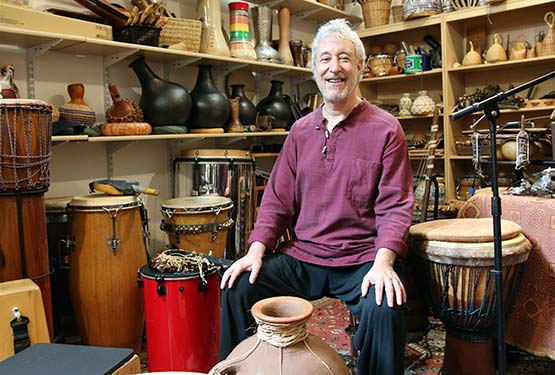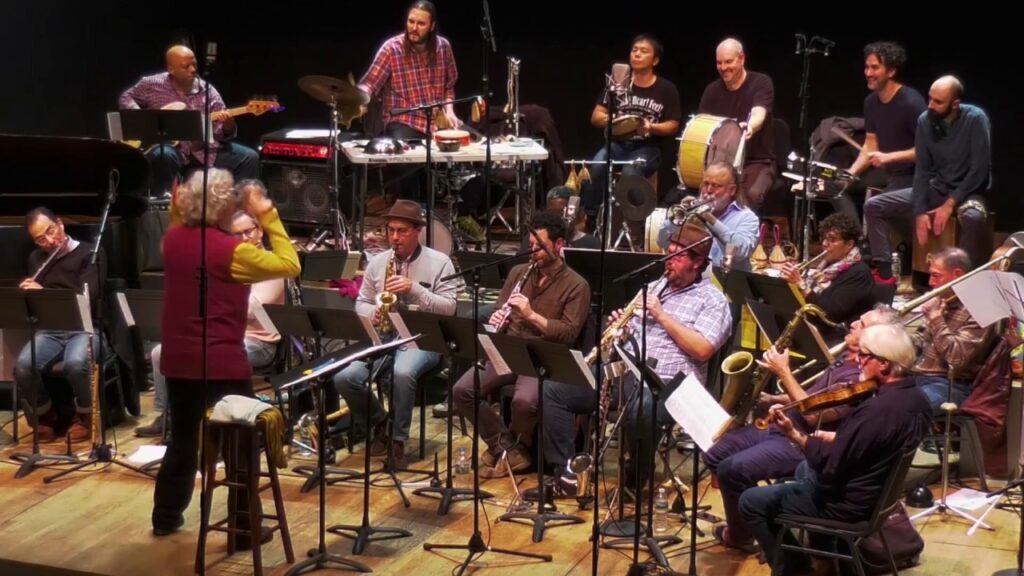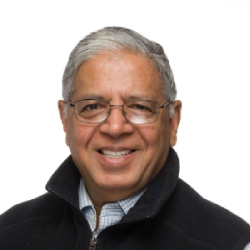BY ADAM RUDOLPH
Speaking over lunch recently, my friend Akhil Gupta spoke to me about his work as director and founder of Universal Enlightenment & Flourishing. We always exchange ideas and share books we read about spiritual and philosophical ideas. He shared with me that he stumbled on a simple but powerful insight that our deepest yearnings are only Love, Learning, and Play (or LLP). Everything else that we do is a means to engaging in those three ultimate ends. The idea really struck a chord in me; here was a way of clearly articulating exactly what we do in music! It seemed to me, too, that the arts in general and music in particular are ways that the concepts of love, learning, and play are shared. That is, LLP is not only intrinsic to each aspect of the creative process, but the creative arts themselves communicate and teach these ideas.
Music in particular and the arts in general not only utilize LLP in the creative process but express them in ways beyond what mere words can do. The philosopher Arthur Schopenhauer writes: “The composer reveals the innermost nature of the world, and expresses the profoundest wisdom in a language that his reasoning faculty does not understand.” That is, LLP is so embedded in the arts that the arts themselves are perhaps the most profound way that a person can be re-awakened to a deeper awareness of them. When the great dancer Isadora Duncan was asked to explain what she was doing in her art, she said she could only dance the answer.
LLP are so intertwined with one another that it is hard to speak fully about them as separate entities. For me, as an artist, they are three qualities of one thing: creative imagination. Creative imagination is the field where I have learned to love, loved to learn, loved to play, and learned to become more playful.
As an artist in music, I work in what I would call the ‘in between world’. In between the material and the immaterial, between body, mind and spirit, between sound and silence, between thought and feeling, Similarly, the relationship between loving, learning and playing is important. In the creative process, LLP flow between one another in a myriad of ways; LLP are processes, not objects. It is the processional and not material aspect of them which makes them so powerful in the service of art.
Music and Spirituality
LOVE
The mystery of love has consumed humans for as long as they have had the consciousness to think about it. For our purposes here, we could consider that love is giving something or someone our attention, energy and devotion.

A musician will spend years of practice to develop their craft so that ideas and feelings can flow freely through their instrument. When we hear this developed artist, we are moved by more than simply dazzling technical virtuosity; we feel the love.
We are touched by an artist’s energy of love that was put into the preparation for the performance. When we hear Ali Akbar Khan or John Coltrane or Stravinsky, we appreciate the beauty or playfulness of the music itself. But in the listening experience, we may also be unconsciously affected by the love they have infused their art with. It touches and moves us as an energy. This is an aspect of love which animates art, and it is part of what we respond to. In addition, listening can become a creative activity when we bring our energy to it. We can open ourselves to deep listening by giving the music our attention and time, to really hear and resonate with the music.
It can happen that the more time and energy we give to something, we can learn to love it. It has been said that music is like an ocean without bottom; no one person can learn all there is to know about it. Love of music has motivated me to spend a lifetime of learning everything I can about it. In turn, learning and exploring has deepened the love. When I recently learned even more about the concept of Rasa (translated as emotional coloration) in Indian music and arts, it broadened even more my love and respect for what humans can create. It motivated me to continue to learn more about the philosophical underpinnings of other musical disciplines. It inspired me to look at my own music in a new light.
Role of Music
LEARN
For an artist, learning the craft of their art comes first. Musicians learn songs, rhythms, dances, scales, etc, to gain facility on their instruments. Any excellent performer will have spent hours each day over many years to become facile and technically proficient. A composer can spend a lifetime studying ideas, theory and compositional processes in developing their art.
Many musicians choose to continue learning long after they have been acknowledged as accomplished artists and are considered successful professionally. When I asked Yusef Lateef why, in the mid-1950s, he decided to begin his study of music from cultures outside his own, he said, “I knew if I wanted to have a long career in music, I should learn everything I can about every kind of music in the world.” His attitude of curiosity and studiousness is something I have taken to heart.
In any music where improvisation is important, ready openness to the “spirit of the moment” is essential. It could be seen as “learning in the moment”. Everything about the time during an improvised performance is important to that spontaneous learning; the air, the audience, the musicians’ mind set, my mood, where the planet was in the cosmos — all of it. Even if things were similar the next night, the alchemy of the mix of it all could never be the same. I still have to learn on the fly, respond as it happens. I have learned to love the mystery of that spontaneous alchemy.
Spiritual Music
PLAY
Two twentieth-century geniuses, Miles Davis and Picasso, often spoke of childlike playfulness as being essential to their creative process. They developed a practice of playfully allowing their intuition to flow freely. When this way of play-working is a regular practice, a kind of creative freedom is earned. Years of study (learning) and practice(love) eventually endowed them with the knowledge, technique and attitude to befree and playful in their art. For them and for most artists, technique and theory are dry and boring without the infusion of “spirit” or creative imagination nourished by a childlike playful freeness.
All improvisers do this as best they can. In “learning spontaneously” during a performance, it helps to be playful, to not succumb to any perceived seriousness or heaviness of the moment. It means letting go; letting go of judgments, criticism, preconceptions. Letting the mind relax and become quiet.
When we relax our minds in this way, we create and enlarge a resonant space for the imagination to play. We listen to and respect our inner voice. We tune in to our nature of being. Words are limited in describing this consciousness, yet we know when we are in that resonate place of flow or rightness. Like learning to ride a bike or meditate, this kind of learning happens by doing. It becomes a practice.
Learning Music
PRACTICE LLP WITH AN OPEN MIND
I would suggest to readers to reinvent your relationship to music and art in the context of Love, Learn, and Play.
In our modern world, music has been reduced to a commodity: an app on a cell phone, a soundtrack to a sitcom. But listening attentively with the openheartedness of love, listening for the love in the music, opening our minds to learn and experience something new, this activates our own imagination and is where the value of the arts may be. The purpose of the arts is not simply to entertain; it is ultimately to transform consciousness.
Hazrat Inayat Khan, the great Sufi mystic, writes, “When a person learns music he/she need not necessarily learn to be a musician; but by playing, loving and hearing music he/she must develop music in his/her personality. The true use of music is to become musical in one’s thoughts, words and actions. For those who follow the inner path music is essential for their spiritual development.”
Playing Music
The following are a few ideas of how we might grow our relationship with LLP through music.
First, choose your music. It can be fun to listen more deeply to old favorites, but the idea here is not merely to stroll down memory lane. What we are looking for is a creative engagement with the music. Perhaps there is a recording you purchased but did not quite “get” the first time around. Perhaps there is music you read about or a friend told you about that you have never heard. Perhaps there is a composer or performer you know about but never listened to. Perhaps there are recordings of music from a faraway place you might wish to visit someday, or are curious about the culture. Everything is “findable” and downloadable nowadays.
Second, set aside an hour where you can be quiet and focused. Do this practice often, perhaps once a week. Like with any mindfulness practice or physical exercise, the more regularly you do it, the more benefit you will glean.
Third, find a comfortable place to sit or lie, with your CD, LP or computer hooked up to a good sound system or, better yet, a good set of headphones. The idea is to be free of distraction from the outside, so you can relax and focus.
Fourth, close your eyes. Stop, breath and relax. Listen to the music with your whole mind focused upon it. If the mind wanders, simply bring it back to the music. Do not judge! We are leaving the judging mind behind. Do not compare. We are looking for the beauty and humanity and feeling in the sounds.
If the music does not make “sense” to you, do not let that cause anxiety, fear or impatience. Continue to breathe, and with each exhalation, let go again of critical mind. I suggest the following: Listen for the energy of the effort (love, skill, time) that the artists put into making the music. It can be easier to appreciate artistic integrity even if, at first, we are not moved by the music. Again, this is not about judging; this is about opening up your own space of resonance in soul and mind.
If the music makes you want to get up and dance, then do! Be free with your movement, play with movement. We are engaging and activating play, learning and love…so enjoy yourself! Learn how to listen more deeply and try to hear the love in the sounds and those who made them.
AND MORE
Make your own music, draw or paint while you listen to music. Move from watching to doing. Love the process. Learn something new. Be playful. Let engaging the arts be part of your daily practice. Be a deep listener to music. Let the sounds activate imagination. Fall in love with the sound. Learn about it. Who made it and why? Learn about yourself. Why does this music touch you, and where? Let it inspire you. Relax and let the playfulness in your own being breath deeper. Let the music inspire your own creative imagination. Don’t judge. Have fun. Let your true nature of play blossom forth.
ABOUT THE AUTHOR
Adam Rudolph is founder and director of RHYTHMS OF COLLABORATION, the oldest and most respected corporate drum circle company. He has led dozens of drums circles for Fortune 500 hundred companies as well as many non-profits.

Rudolph has been artist in residence at the Center for Advanced Studies at the University of Illinois, with the Danish Radio Orchestra and California Institute of the Arts. He is the recipient of numerous grants and commissions and his methodology book, Pure Rhythm, is studied by musicians worldwide.
Rudolph is known as one the early innovators of what is now called “World Music” and has worked with artists from many cultures. His new recording, Ragmala is a collaboration between his Go: Organic Orchestra and Hindustani and Carnatic musicians from the collective Brooklyn Raga Massive.
More on Adam Rudolph can be found here
His music can be heard here
Corporate Drum Circles by Rhythms of Collaboration
Popular Reads
Flourishing Life |Spiritual Awareness |Flourishing Child Program |False Narrative Definition |Means and Ends |The Value of Play in Early Childhood |Living Consciously |World Wisdom Map |Purpose of Life |Different Types of Perspective |Diverse Humanity


